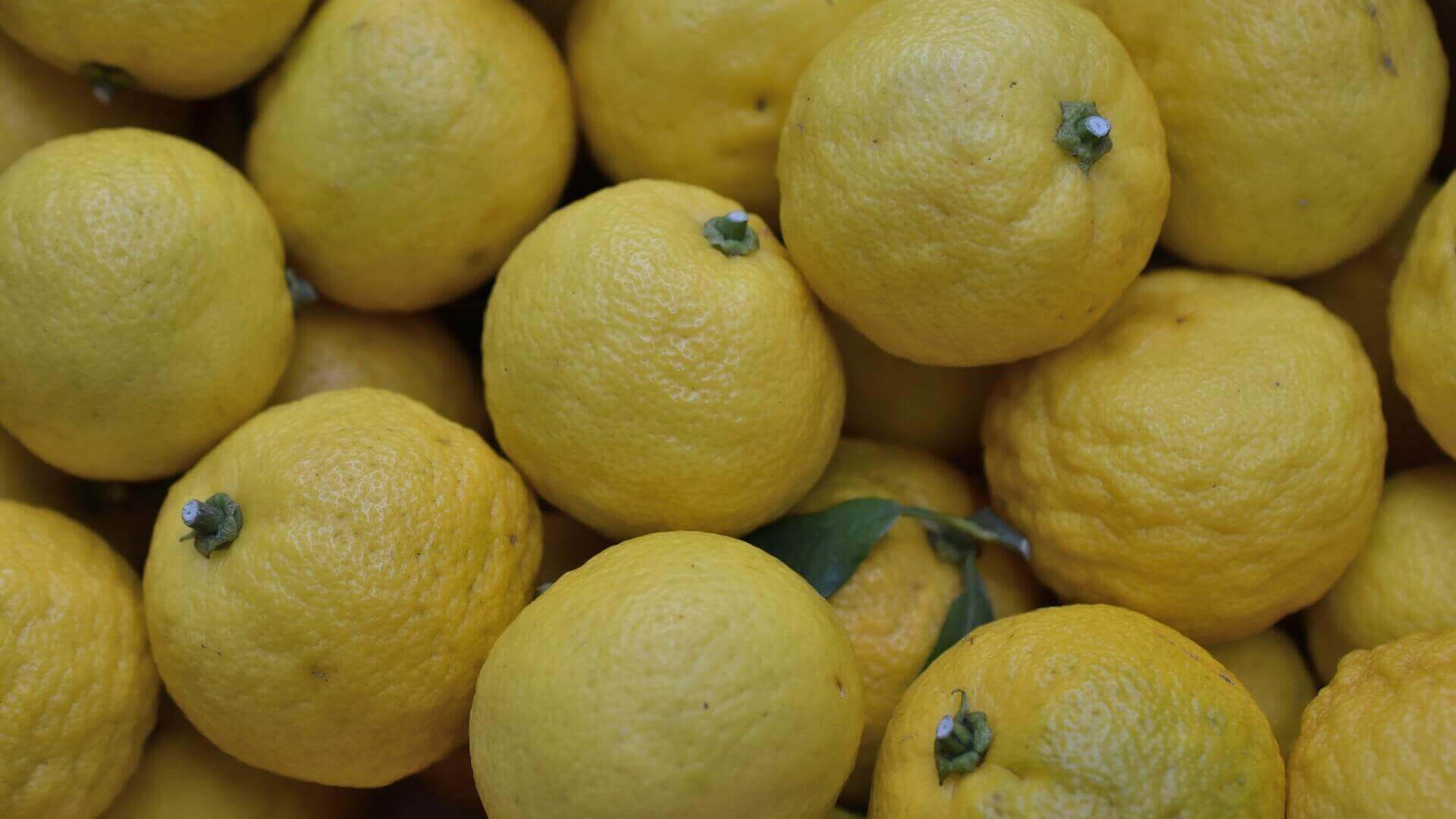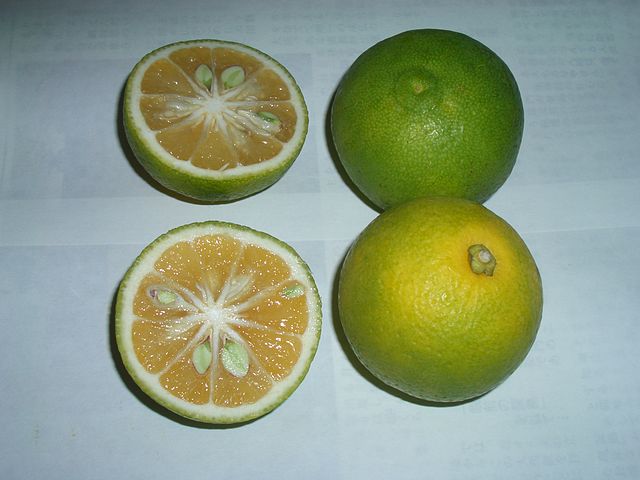Table of Contents

Yuzu has a unique flavour; one way to describe it is to imagine combining orange, mandarine, lemon, and grapefruit. The best way to appreciate the taste and especially the aroma of the fruit is to try to get hold of one and use it as a citrus replacement in one of your favourite cocktail recipes.
It is my favourite ingredient for adding some acidity to drink recipes. If we are looking for something similar to compare or substitute with, the flavour of the Seville orange is close but not the same.
Sometimes, it is hard to get hold of the natural fruit; in that case, we can use yuzu juice or marmalade. However, we still are missing the aromatic essences released by the peel, as they are lightly sweet and rich in aromatic oils when the skin is squeezed or muddled.
The yuzu fragrance is entirely its own; there is nothing like it on this side of the pond.
Before I get to one of the mine recipes I posted here, I will explore the origins of the fruit and its different uses.
Yuzu Origin

Yuzu has a history of over 1200 years. It is believed the fruit originated in Tibet and central China, the Yangtze River Region, as a hybrid of mandarin orange and the ichang papeda, where it still grows wild. Due to its cold-hardy ichang papeda ancestry can grow in temperatures as low as -9° C. The fruit varies in size, from small lemon to grapefruit-size, and it grows as a small tree or shrub-sized plant1.
Even though it originated in China, Japan is mainly associated with cultivating and producing the yuzu. It was brought to Japan through the Korean peninsula, known as Yuja, during the Nara Period (year 710). Still, the Japanese farmers grew it for three purposes: culinary, hot bathing, and medicinal2.
In Korea, Yuzu is known as Yuja and is used to make Yuja-cha – marmalade, Yuja tea, and various salads and main dishes.
The growing period is between April and December. It produces small green-coloured fruit, which turns into a golden-yellow colour with a spherical shape by the end of the growing period.
In the US, at this moment, yuzu is not allowed to be imported, but one can grow it; the few places that I’m aware of are in California and New Jersey. In Canada, we can buy the fruit in Japanese stores or grow it in Vancouver and Richmond.
Yuzu Substitutes
I know of no substitutions in North America, while in Japan, some fruits are part of the Yuzu family with similar flavour profiles.
- Sudachi: a cross between yuzu-koji and Tachibana orange; used as a food flavouring in place of lemon or lime
- Kabosu: ichang papeda – bitter orange hybrid; taste like Sudachi – little sourer
- Okinawan Lime /Shiikuwasha – The taste is between lime and orange, with a low sugar content and is very sour.



If one can not find the fruit, the easier way to enjoy the aromatics is to buy yuzu juice or Yuja–cha—marmalade, which can be used to make tea.
I used Yuja-cha in cocktails, a jar I bought in a local Toronto store, the same way honey is used. It has a nice citrus flavour but is “better than nothing.” I will try to get hold of the actual fruit or juice, especially if the marmalade has many additives and high fructose corn syrup. Unless you make real Korean yujacha and tea, try to stay with the fruit or the juice.
Yuja tea
1 part Yuja / yuzu
1 part honey
1 part sugar
Clean the fruit and cut it into small pieces; remove only the seeds. Mix with sugar and honey.
Put into a container and store in a dark, cool place.
To drink: stir 1-2 teaspoons in hot water.
Use some water to dissolve them before mixing them with ice for cocktails.
Note: Use lemons or any citrus of choice to make similar tea. Skip honey for a more precise colour and pure yuzu taste.
Yuzu Versatility
In the culinary industry, yuzu is a critical ingredient in ponzu sauce, citrus-based sauce (citrus juice of sudachi, Yuzu, and kabosu and vinegar), soy sauce, sugar, or mirin, and dashi, often served with cold noodles or fried pork.
The juice can be used, fresh or cooked in many dishes, for seasoning potato chips, added to many desserts, and is the favourite flavour for candy. The fruit is also used to make Yuzu vinegar.
Here are some recipes on the Japan Center website for people looking for culinary ideas.

In the beverage industry, yuzu infuses liquor, adds unique aromas to cocktails and teas such as Matcha, or makes refreshing non-alcoholic carbonated drinks.
The fruit doesn’t have a lot of juice, and using it in a way we are used to with lime or lemons will not fully incorporate the yuzu aroma in the drinks, as the aromatics are in the skin. The best way to fully enjoy it and to extract all the magic from the yuzu is to muddle, zest, or grind the peel3.
Here is a recipe for Yuzu-infused vodka.
2 cups vodka
2-3 yuzu fruit*, rinsed well and quartered – it depends on the vessel will be using
Quart size Mason jar or the bottle itself
How to:
Place yuzu and vodka in the jar and close it tight. Store it in a dark, cool place.
Occasionally, shake the jar lightly and check the taste in about a week. It should be ready in about 10-14 days.
Strain and discard the fruit. Keep it a cool, dark place.
Note: Yuzu comes in different sizes, from lime to grapefruit size-like; the suggested 2-3 fruits are small to medium.
Health facts
Yuzu is low in calories and highly nutritious. 3.5 ounces (100 grams) provides:
• Calories: 53
• Carbs:13.3 grams
• Protein:0.8 grams
• Fat:0.3 grams
• Fiber: 1.8 grams
• Vitamin C:59% of the Daily Value (DV)
• Vitamin A:31% of the DV
• Thiamine:5% of the DV
• Vitamin B6:5% of the DV
• Vitamin B5:4% of the DV
• Copper: 5% of the DV
It also contains smaller amounts of magnesium, iron, zinc, calcium, riboflavin, niacin, and vitamin E. It has the compounds carotenoids, flavonoids, and limonoids.
According to: www.healthline.com
I created several cocktails made with yuzu, 8 to be precise, and this one of them.
Yuzu Cocktail Recipe
ŻUBRÓWKA BISON GRASS VODKA WITH REAL YUZU FRUIT
Vodka, Aperol, and Yuzu cocktail
Ingredients
- 1½ oz Żubrówka vodka
- ½ oz Aperol
- ½ yuzu fruit - sliced
- 12 blueberries
- ½ oz simple syrup
- ¼ oz lime juice
Instructions
- Muddle yuzu fruit, blueberries, simple syrup, and lime juice.
- Add the rest and hard shake with ice.
- Strain over crushed ice, or straight up into chilled cocktail glass.
- Top with a splash of soda water – optional.
- Garnish with yuzu peel, or squeeze and discard.
Notes
Yuzu varies in size, if it looks like grapefruit - use 1/4 of it, or adjust to your liking.
Double strain, if seeds not removed prior to mixing.
Top image – Wiki Commons



